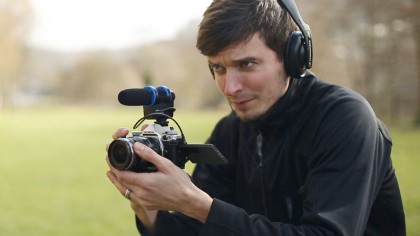Video A-Z
Baffled by video jargon? Our A-Z covers basic know-how right through to pro hardware

If you use a DSLR or compact system camera with manual exposure control in the video mode, it's going to look as if the exposure control is exactly the same as it is for stills – you can set the shutter speed, the lens aperture and the ISO.
Actually, though, video requires a different approach – and the key difference is the shutter speed.
In stills photography you choose a fast shutter speed to freeze action or a slow shutter speed to produce creative blur.
In video you're more restricted. If you use a fast shutter speed, you get a jerky, 'brittle' appearance – video relies on the eye's 'persistence of vision' to look smooth, and this works much better when there's less visual difference between the frames. Slower shutter speeds may produce more blur in each frame, but the frames will 'join up' better when they're played back.
Of course, there is a limit to how slow you can go. You'll be shooting video at 25fps or 30fps, so obviously your shutter speed needs to be faster than that.
In fact, most videographers go for a shutter speed of twice the frame rate. If you're shooting at 30fps, this means a shutter speed of 1/60sec. If you're shooting slow motion at 60fps, you'll need a shutter speed of 1/120sec (the nearest on most cameras will be 1/125sec).
Shutter speed is rarely used as an exposure control by videographers (unless they need to avoid flicker with certain light sources or monitors visible in the scene) which is why you'll rarely hear them talking about it. Instead, the prime exposure control is the lens aperture, or 'iris'.
Get daily insight, inspiration and deals in your inbox
Sign up for breaking news, reviews, opinion, top tech deals, and more.
It's the same thing, just a difference in jargon. Stills photographers adjust the lens aperture, videographers adjust the iris setting.
It is important to get the exposure right for video. In stills photography you can shoot raw files to capture a higher dynamic range and get more processing 'headroom'. In video, only high-end cameras offer raw capture, so mostly you're restricted to capturing compressed video with the image characteristics 'baked in'. It's like shooting JPEG images on a regular camera – you need to get the settings right when you shoot.
Some cameras will offer wide dynamic range picture or gamma profiles, or even LOG modes, which drastically flatten the 'curve' and allow capturing of a huge dynamic range within the limited acquisition format. Beware though, these images will appear very flat and 'milky', so will need post processing work to adjust the contrast back to a natural looking image, and if you're capturing in a highly compressed format, the drastic adjustments needed may 'tear' the image apart at the seams. Zebra patterns and histograms can help you analyse the exposure to make sure you're not accidentally crushing the shadows or blowing out the highlights, and more and more video cameras are coming with these built in.
Current page: Exposure control for video
Prev Page Video file formats vs codecs Next Page Variable ND filter
Rod is an independent photographer and photography journalist with more than 30 years' experience. He's previously worked as Head of Testing for Future’s photography magazines, including Digital Camera, N-Photo, PhotoPlus, Professional Photography, Photography Week and Practical Photoshop, and as Reviews Editor on Digital Camera World.